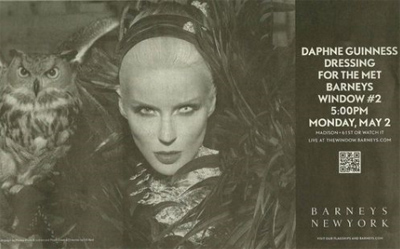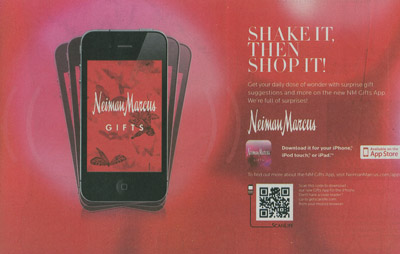Best practice for department stores using QR codes
The use of QR codes can be an important tactic to engage with consumers because, opposed to smaller luxury boutiques, department stores are large and have a sizeable customer base. Therefore, the incorporation of another touch point in which to connect with a consumer will allow a consumer to feel appreciated, even amongst hoi polloi.
“QR codes can be used to help a department store to build a valuable one-on-one relationship with the consumer based on interaction and relevance which would otherwise not be possible,” said Laura Marriott, CEO and acting board chairperson of NeoMedia, an Atlanta-based 2D bar code solutions company.
“This is especially important for department stores which, because of their size and scale, tend to have fewer physical touch points with the consumer,” she said.
In-store attention
Affluent consumers are the most likely to pay premium prices for smartphones and the data plans that go along with them.
Furthermore, wealthier individuals tend to be more educated and therefore up-to-date and savvy with the latest trends.
“The relative newness of bar codes to the mass market means that brands need to consider placing descriptive copy next to the QR code, explaining what the code is, how it is used, how to download a reader to scan the code and what it will provide them with,” Ms. Marriott said. “This will help to facilitate and encourage consumer participation.”
Barneys New York has started to use QR codes to promote the retailer’s collaboration with Daphne Guinness in preparation for the Met Gala (see story).
The department store placed the codes in different media, including print ads in the New York Times, that promoted the event in the Barneys windows.

Print ad in the NY Times
This tactic will inevitably draw traffic to the bricks-and-mortar location and therefore increase the possibility of sales in-store.
“Luxury shoppers may be less likely to buy on-line, so getting them into the store experience is critical,” said Mike Wehrs, CEO of Scanbuy, New York. “It’s less about offers and more about seeing the product in a more engaging way using the mobile device.
“This could be video, additional images or calling to make an appointment,” he said.
Mobile madness
Ways that department stores choose to use QR codes vary between in-store, print, mail and out-of-home ads.
For instance, Bloomingdale’s and Bergdorf Goodman use QR codes both in the catalogs and mail that they sends to customers (see story).
Bloomingdale’s takes it a step further and places them in out-of-home ads such as telephone booths as well.
Additionally, Neiman Marcus puts bar codes in newspaper advertisements that link to its Neiman Marcus Gifts iPhone application (see story).

Neiman Marcus’ bar code
“There are countless opportunities for retailers to use QR codes in marketing campaigns, enabling new forms of interactivity and dialogue between the consumer and retailer,” NeoMedia’s Ms. Marriott said.
“The reason that department stores have been so quick to adopt QR codes is first, they understand that many shoppers are now using their mobile phones to aid in purchase decisions, so it’s important that they offer shoppers a meaningful mobile experience,” she said.
QR codes are proving beneficial to luxury department stores because there are many ways in which they can complement shopper activity.
Activating out-of-home ads, incentivizing purchase and upsell from planned purchases and generating sign-up for retail loyalty programs can help to ensure that the shopper feels like a valued, individual customer.
Brands should also track consumer interaction and purchase habits and create a shopping experience by providing opportunities for customer engagement and product activation.
Scanbuy’s Mr. Wehrs agrees.
“Department stores sell a wide variety of products so codes can add a lot of value in cross-sell opportunities by providing more detailed information and recommendations based on what they are interested in,” Mr. Wehrs said.
“A customer could potentially scan about getting tips on spring fashion and see information about a sale on cosmetics from a completely different floor,” he said.
Final Take
Rachel Lamb, editorial assistant on Luxury Daily, New York
